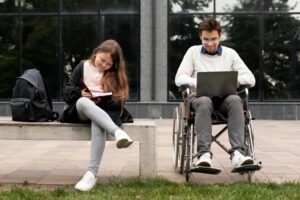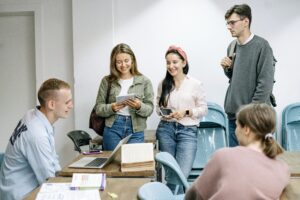Inclusive digital Education Synergies
Materials
1. Introduction
Synergies for inclusive digital education involve combining various elements and strategies to ensure that education is accessible and beneficial for all individuals, regardless of their background, abilities, or circumstances. it is possible to affirm that the social sense is inherent to educational digital inclusion. It is noticed that this consideration has educational inclusion as a superior category, which can be referred to as the creation of conditions for citizen training in order to achieve social participation, with an emancipatory sense, which guarantees the continuity of the educational system (Krichensky, 2009, cited in Macchiarola et al., 2018). Because educational inclusion pursues citizen training through a participatory role, it is strongly linked to an egalitarian sense: “it is a process aimed at guaranteeing the right to quality education to all students under equal conditions, paying special attention to those who are in a situation of greater exclusion or at risk of being marginalized” (OEI, n/d, cited in Colás-Bravo et al., 2019, p. 171).
“In the context of ICT, accessibility is defined as “the art of ensuring that any resource, through any medium, is available to all people, whether or not they have a disability” (Berners-Lee and Fischetti, 1999).
1.1 Purpose of this learning unit
Inclusive digital education can yield a variety of positive results, impacting students, educators, and the educational system as a whole. The purpose of this unit is to learn how Inclusive digital education provides personalized learning experiences, allowing students to progress at their own pace and according to their learning styles.
2. Indicators of inclusive digital education systems and inclusive digital teaching practices
After the documentary review of empirical evidence, it was detected that educational inclusion, understood as an egalitarian social right, generates greater inequalities than solutions in the educational institutions that seek to help. Digital inclusion processes involve an infinite number of variants (technical, professional and school), at the same time, there is institutional diversity, so it is essential to implement differentiated actions in order to strengthen the institutions with the greatest lag, either for structural or cultural reasons (Macchiarola et al., 2018).
This problem can be reflected if we place ourselves in the subject-object relationship from the egalitarian sense that characterizes educational inclusion.
2.1 Educational inclusion factors
- Accessible Technology: Ensure that digital platforms and educational resources are designed with accessibility features, such as screen readers, closed captions, and adjustable text size, Collaborate with technology developers to create tools that are user-friendly for individuals with disabilities.
- Personalized Learning Paths: Utilize adaptive learning technologies to provide personalized learning experiences based on individual needs, preferences, and progress. Implement data analytics to track student performance and customize educational content accordingly.
- Collaborative Learning: Foster a collaborative and inclusive online learning environment where students can work together, share ideas, and learn from each other. Use online discussion forums, group projects, and collaborative tools to encourage interaction among students.
- Teacher Training and Professional Development: Provide training for educators to effectively use digital tools and technologies to accommodate diverse learning styles and needs. Include modules on inclusive teaching practices and strategies for addressing the needs of all students.
- Cultural Sensitivity and Diversity: Incorporate diverse perspectives, cultures, and experiences into the digital curriculum to make it more relatable and inclusive. Provide content that reflects the diversity of the student population, fostering a sense of belonging and understanding.
- Flexible Assessment Methods:Implement a variety of assessment methods, allowing students to demonstrate their understanding in different ways. Offer alternatives such as oral presentations, project work, and portfolio assessments to accommodate diverse learning styles.
- Community Engagement:Involve parents, caregivers, and local communities in the education process, especially in the case of remote learning.Utilize digital communication channels to keep stakeholders informed and engaged in the educational journey of students.
- Infrastructure and Connectivity: Ensure access to reliable internet and necessary devices for all students, bridging the digital divide. Collaborate with governments, NGOs, and private sectors to improve infrastructure and connectivity in underserved areas.
- Continuous Feedback and Improvement: Collect feedback from students, educators, and parents to continually improve the inclusivity of digital education. Regularly update and adapt digital resources based on evolving needs and emerging technologies.
Educational instances go through countless problems in institutional, cultural, curricular and technical terms. It is recurrent to observe the implementation of strategies, systematically applied at intervals of time (previously established from outside) that are far from considering the particular needs of teachers and students, who live these processes most of the time from resistance and confusion. It is likely that continuing to think of exclusions towards the periphery and not inside the institutions, where confusion, uncertainties and lack of skills to successfully incorporate ICTs take place, will probably lead to the same scenarios and, consequently, to the same achievements in terms of progress.
2.2 Different indicators and teaching practices
To understand those synergies, we should be aware that there are different indicators and teaching practices from different perspectives and those would be taking into consideration to start working for a real and practice Inclusive digital education, starting from two different perspectives (Maggio, 2012):
Leadership/School’s Perspective:
- Foster collaboration among educators, administrators, and other stakeholders to share best practices and resources, Establish partnerships with community organizations, businesses, and other schools to enhance access to technology and expertise.
- Infrastructure and Equipment/Tools and Technology:Invest in robust technological infrastructure to ensure seamless connectivity and access to digital tools.
- Regularly update and maintain hardware and software to keep up with advancements in educational technology.
- Continuing Professional Development: Provide ongoing professional development opportunities for educators to enhance their digital literacy skills.
- Support educators in staying updated on the latest trends and tools in digital education.
Teacher’s Perspective:
- Pedagogy Supports and Resources: to provide teachers with a variety of digital resources, curriculum materials, and teaching aids. Offer support for creating inclusive lesson plans and adapting materials to meet the diverse needs of students.
- Pedagogy Implementation in the Classroom/Pedagogic Approach encourages teachers to adopt inclusive pedagogical approaches that leverage technology to address different learning styles.
- Facilitate the use of project-based learning, collaborative activities, and interactive multimedia to engage students.
2.3 Inclusion Assessment:
Assessment Practices are part of this work to develop inclusive assessment strategies that accommodate diverse learning styles and abilities. That is why it should be explored alternative assessment methods, such as project-based assessments, to provide a more comprehensive view of student performance. Due to students’ perspective, the necessity of implementing student digital competence to incorporate digital literacy skills into the curriculum to empower students to navigate and critically evaluate digital information and foster a culture of responsible and ethical digital behavior among students. Educational institutions can develop a holistic and inclusive approach to digital education that addresses the needs and perspectives of all stakeholders involved. (Maggio, 2012).
3. Methods
Because educational inclusion pursues citizen training through a participatory role, it is strongly linked to an egalitarian sense: “it is a process aimed at guaranteeing the right to quality education to all students under equal conditions, paying special attention to those who are in a situation of greater exclusion or at risk of being marginalized” (OEI, n/d, cited in Colás-Bravo et al., 2019, p. 171).In this regard, here are some methods to achieve this integration of digital education:
1. Differentiated Instruction: Tailor instruction to meet the individual needs of students, providing varied levels of difficulty, formats, and resources.Use digital tools to offer alternative pathways for learning and assessment.
2. Adaptive Learning Technologies: Implement adaptive learning platforms that adjust content and activities based on individual learner progress.Personalize learning experiences to address specific strengths and challenges.
3. Collaborative Learning: Facilitate collaborative online activities, group projects, and discussions to encourage peer learning.Use digital platforms to support cooperative learning experiences.
4. Multimodal Learning Materials: Present information through a variety of formats, such as text, audio, video, and interactive simulations. Accommodate different learning preferences by offering diverse multimedia resources.
5. Accessible Digital Content: Ensure that all digital content meets accessibility standards, allowing individuals with disabilities to access information. Provide alternative formats, such as text transcripts and captions, for audio and video content.
6. Flipped Classroom Model: Use the flipped classroom approach, where students review instructional materials online at their own pace before engaging in interactive and collaborative activities during class time. This approach allows students to learn at their own pace and revisit materials as needed.
“it is a process aimed at guaranteeing the right to quality education to all students under equal conditions, paying special attention to those who are in a situation of greater exclusion or at risk of being marginalized” (Colás-Bravo, 2019)
7. Gamification and Interactive Simulations: Integrate gamified elements and interactive simulations to enhance engagement and understanding.Use digital games and simulations to reinforce concepts and provide real-world applications.
8. Digital Storytelling: Incorporate digital storytelling as a means of expression and understanding.Encourage students to create and share their stories using various multimedia elements.
9. Culturally Responsive Teaching: Embed diverse perspectives and cultural references in digital content and activities. Acknowledge and celebrate the cultural backgrounds of students to create an inclusive learning environment.
10. Virtual Reality (VR) and Augmented Reality (AR): Use VR and AR technologies to create immersive learning experiences. These technologies can help simulate real-world scenarios, making learning more interactive and engaging.11. Self-Paced Learning Modules: Develop self-paced learning modules that allow students to progress at their own speed. Provide additional support or challenges as needed, allowing for a more personalized learning experience.
11. Inclusive Assessment Practices: Implement varied assessment methods, such as project-based assessments, portfolios, and open-book exams. Offer alternative assessments that allow students to demonstrate their understanding in different ways.
12. Continuous Feedback and Reflection: Provide regular feedback to students, focusing on strengths and areas for improvement. Encourage self-reflection and goal-setting to empower students in their learning journey.
4. Results
Inclusive digital education can yield a variety of positive results, impacting students, educators, and the educational system as a whole. Inclusive digital education provides personalized learning experiences, allowing students to progress at their own pace and according to their learning styles. Tailoring instruction to individual needs can lead to improved understanding and mastery of concepts and increased Engagement and Motivation such as making learning more dynamic and relevant. It can also cater to learners with physical disabilities or special needs, ensuring a more inclusive educational experience, and creating Adaptive learning technologies and personalized approaches allow for diverse learning pathways, accommodating various learning speeds, preferences, and abilities.
Recognition and celebration of diversity in content and teaching methods promote a culture of inclusion. Inclusive digital education instills a love for learning and the ability to adapt to new information and technologies. Students develop the skills needed for continuous learning, essential in a rapidly evolving digital landscape, open up opportunities for global collaboration, connecting students and educators from different parts of the world and can promote cultural exchange and the sharing of diverse perspectives.
While these outcomes are promising, it’s important to acknowledge that the effectiveness of inclusive digital education depends on thoughtful implementation, ongoing support, and continuous evaluation and improvement. Additionally, challenges such as the digital divide and accessibility issues need to be addressed to maximize the benefits for all learners.
Case Study: Gamified Learning for Diverse Learners: An educational game company develops a platform designed for diverse learning needs. Gamification is a powerful tool that can be used to engage and motivate diverse learners. By incorporating game design elements and mechanics into educational experiences, educators can create inclusive and accessible learning environments that cater to the needs of all learners. By using strategies such as personalization, relevance, feedback, and simulation, educators can make learning more engaging and effective for diverse learners.
Synergies involved:
- Adaptive Learning: Customizing the learning experience based on individual performance and needs.
- Engagement: Using gamification to motivate and engage students.
- Differentiated Instruction: Offering different levels of challenges and supports within the game.
- Inclusive Content: Ensuring game content is culturally relevant and accessible to all students.
5. Conclusion
In conclusion, inclusive digital education represents a paradigm shift towards a more student-centered, equitable, and globally connected educational landscape. While challenges persist, the potential benefits are substantial, making it a crucial avenue for shaping the future of education. Continuous collaboration, research, and commitment from all stakeholders are essential for realizing the full potential of inclusive digital education and ensuring that it serves the needs of diverse learners effectively.
References
Bugaj , C. (2018) The New Assistive Tech: Make Learning Awesome for All. International Society for Technology.
Rapp, W. (2012) Teaching Everyone: An Introduction to Inclusive Education. Brookes Publishing
Sorensen, C. (2009) Digital Inclusion: Measuring the Impact and Empowering the Nation. Information Today
Online Articles
Smith, J. A. (2021). Inclusive digital education synergies: A comprehensive review. Journal of Educational Technology, 25(2), 123-145. https://www.sciencedirect.com/science/article/pii/S2666412722000137
Johnson, M. B. (2019). Digital learning for all: Synergizing inclusive practices.
Macchiarola, V.; Martini, C.; Montebelli, A. y Mancini, A. (2018). Inclusión digital educativa en escuelas secundarias argentinas. Un estudio evaluativo. Ciencia, Docencia y Tecnología, 29(57), pp. 1-18. https://www.redalyc.org/articulo.oa?id=14560144013
Colás-Bravo, P.; Giuseppe, P.; Pablos-Pons, J.; Conde-Jiménez, J. y Villaciervos, P. (2019). Aplicaciones digitales para la inclusión. El proyecto Europeo DEPIT. Revista de Comunicación de la SEECI, 50, pp. 169-192. https://doi.org/10.15198/seeci.2019.50.169-192
Maggio, M. (2012). Entre la inclusión digital y la recreación de la enseñanza: el modelo 1 a 1 en Argentina. Revista Científica de Tecnología Educativa, 1(1), pp. 51-64. http://uajournals.com/ojs/index.php/campusvirtuales/article/view/19
2. Collaboration and Networking
Synergies of Inclusive Education
Synergies of Inclusive Edication
15 min
Identify and research on Synergies for inclusive digital education that involve combining various elements and strategies to ensure that education is accessible and beneficial for all individuals, regardless of their background, abilities, or circumstances.
Accessibility, Equity Diversity, Universal Design for Learning Digital Divide, Assistive Technology, Inclusive Pedagogy Multimodal Learning, Differentiated Instruction. Digital Literacy Remote Learning E-learning Blended Learning








Funded by the European Union. Views and opinions expressed are however those of the author(s) only and do not necessarily reflect those of the European Union or the European Education and Culture Executive Agency (EACEA). Neither the European Union nor EACEA can be held responsible for them (2022- 1 -SI01 -KA220-HED-000088368).






